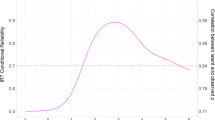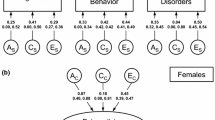Abstract
We investigated the heritability of liability to affective illness (AI) in twins ascertained through psychiatric hospitalization for AI from the Swedish Psychiatric Twin Registry and from the general population Swedish Twin Registry. Lifetime diagnoses were assessed by mailed questionnaire containing, in self-report format, DSM-III-R criteria for mania and major depression (MD). Jointly analyzing both subsamples using Mx, and assuming a multifactorial threshold model, the best-fitting twin model using narrow diagnostic criteria suggested that the liability to AI could be explained by additive genetic effects, with an estimated heritability of liability of 64%, and individual-specific environment. Using broad criteria, results were similar except that the estimated broad heritability of liability was higher (83%) and due largely to dominance genetic effects. Fitting sex-dependent models suggested that the same genetic and environmental factors influenced liability to AI in men and women to the same degree, although women had a lower threshold of manifestation. These results suggested that in Sweden, AI is a highly heritable syndrome and family resemblance is due largely or entirely to genetic factors.
Similar content being viewed by others
References
Akaike, H. (1987). Factor analysis and AIC.Psychometrika 52:317–332.
American Psychiatric Association (1980).Diagnostic and Statistical Manual of Mental Disorders, 3rd ed., American Psychiatric Association. Washington, DC.
American Psychiatric Association (1987).Diagnostic and Statistical Manual of Mental Disorders, rev. 3rd ed., American Psychiatric Association, Washington, DC.
Andrews, G., Stewart, G., Allen, R., and Henderson, A. S. (1990). The genetics of six neurotic disorders: A twin study.J. Affect., Disord. 19:23–29.
Baron, M. (1980). Genetic models of affective disorder: Application to twin data.Acta Genet. Med. Gemellol. 29:289–294.
Berkson, J. (1946). Limitations of the application of fourfold table analysis to hospital data.Biometr. Bull. 2:47–53.
Bertelsen, A., Harvald, B., and Hauge, M. (1977). A Danish twin study of manic-depressive disorders.Br. J. Psychiat. 130:330–351.
Bromet, E. J., Dunn, L. O., Connell, M. M., Dew, M. A., and Schulberg, H. C. (1986). Long-term reliability of diagnosing lifetime major depression in a community sample.Arch. Gen. Psychiat. 43:435–440.
Brown, G. W., and Harris, T. O. (1978).Social Origins of Depression: A Study of Psychiatric Disorder in Women, Tavistock, London.
Cadoret, R. J., O'Gorman T. W., Heywood, E., and Troughton, E. (1985). Genetic and environmental factors in major depression.J. Affect. Disord. 9:155–164.
Cederlof, R. (1966).The Twin Method in Epidemiological Studies on Chronic Disease, University of Stockholm, Doctoral dissertation, Stockholm, Sweden.
Cederlof, R., Friberg, L., Jonsson, E., and Kaij, L. (1961). Studies on similarity diagnosis in twins with the aid of mailed questionnaires.Acta Genet. Med. Gemellol. 11: 338–362.
Crow, J. F. (1965). Problems of ascertainment in the analysis of family data. In Neel, J. V., Shaw, M. W., and Schull, W. J. (eds.),Genetics and the Epidemiology of Chronic Diseases, U.S. Department of Health, Education and Welfare, Washington, DC, pp. 23–44.
Eaves, L. J. (1972). Computer simulation of sample size and experimental design in human psychogenetics.Psychol. Bull. 77:144–152.
Eaves, L. J., Eysenck, H. J., Martin, N. G.,et al. (1989).Genes, Culture and Personality: An Empirical Approach, Oxford University Press, London.
Falconer, D. S. (1965). The inheritance of liability to certain diseases, estimated from the incidence among relatives.Ann. Hum. Genet. 29:51–76.
Faraone, S. V., Lyons, M. J., and Tsuang, M. T. (1987). Sex differences in affective disorder: Genetic transmission.Genet. Epidemiol. 4:331–343.
Gershon, E. S., Hamovit, J., Guroff, J. J., Dibble, E., Leckman, J. F., Sceery, W., Targum, S. D., Nurnberger, J. I., Goldin, L. R., and Bunney, W. E. (1982). A family study of schizoaffective, bipolar I, bipolar II, unipolar, and normal control probands.Arch. Gen. Psychiat. 39:1157–1167.
Goodwin, F. K. and Jamison, K. R. (1990).Manic-Depressive Illness, Oxford University Press, New York.
Heath, A. C., Berg, K., Eaves, L. J., Solaas, M. H., Corey, L. A., Sunder, J., Magnus, P., and Nance, W. E. (1985). Education policy and the heritability of educational attainment.Nature 314:734–736.
Johnson, R. A., and Wichern, D. W. (1982).Applied Multivariate Statistical Analysis, Prentice-Hall, Englewood Cliffs, NJ.
Kendler, K. S. (1988a). The impact of diagnostic hierarchies on prevalence estimates for psychiatric disorders.Compr. Psychiat. 29:218–227.
Kendler, K. S. (1988b). The familial aggregation of schizophrenia and schizophrenia spectrum disorders: An evaluation of conflicting results.Arch. Gen. Psychiat. 45:377–383.
Kendler, K. S., and Holm, N. V. (1985). Differntial enrollment in twin registries: Its effect on prevalence and concordance rates and estimates of genetic parameters.Acta Genet. Med. Gemellol. 34:125–140.
Kendler, K. S., and Kidd, K. K. (1986). Recurrence risks in an oligogenic threshold model: The effect of alterations in allele frequency.Ann. Hum. Genet. 50:83–91.
Kendler, K. S., Neale, M. C., Kessler, R. C., Heath, A. C. and Eaves, L. J. (1992a). A population based twin study of major depression in women: The impact of varying definitions of illness.Arch. Gen. Psychiat. 49:257–266.
Kendler, K. S., Neale, M. C., Kessler, R. C., Heath, A. C., and Eaves, L. J. (1992b). Childhood parental loss and adult psychopathology in women: A twin study perspective.Arch. Gen. Psychiat. 49:109–116.
Kendler, K. S., Neale, M. C., Kessler, R. C., Heath, A. C., and Eaves, L. J. (1993a). The lifetime history of major depression in women: Reliability of diagnosis and heritability.Arch. Gen. Psychiat. 50:863–870.
Kendler, K. S., Pedersen, N. L., Johnson, L., Neale, M. C. and Mathe, A. A. (1993b). A pilot Swedish twin study of affective illness, including hospital- and population-ascertained subsamples.Arch. Gen. Psychiat. 50:699–706.
Kendler, K. S., Walters, E. E., Truett, K. R., Heath, A. C., Neale, M. C., Martin, N. G., and Eaves, L. J. (1994). The sources of individual differences in depressive symptoms: An analysis of two twin-family samples.Am. J. Psychiat. 151:1605–1614.
Martin, N. G., Eaves, L. J., Kearsey, M. J., and Davies, P. (1978). The power of the classical twin study.Heredity 40:97–116.
Mather, K., and Jinks, J. L. (1982).Biometrical Genetics: The Study of Continuous Variation, 3rd ed., Chapman & Hall, London.
McGuffin, P., and Katz, R. (1989). The genetics of depression and manic-depressive illness.Br. J. Psychiat. 155:294–304.
McGuffin, P., Farmer, A. E., Gottesman, I. I., Murray, R. M., and Reveley, A. M. (1984). Twin concordance for operationally defined schizophrenia: Confirmation of familiality and heritability.Arch. Gen. Psychiat. 41:541–545.
McGuffin, P., Katz, R., and Rutherford, J. (1991). Nature, nurture and depression: A twin study.Psychol. Med. 21:329–335.
McGuffin, P., Katz, R., Rutherford, J., Watkins, S., Farmer, A. E., and Gottesman, I. I. (1993). Twin studies as vital indicators of phenotypes in the search for molecular genotypes. In Bouchard, T. J., and Propping, P. (eds.),Twins as a Tool of Behavioral Genetics: Report of the Dahlem Workshop on What Are the Mechanisms Mediating the Genetic and Environmental Determinants of Behavior? J. Wiley, Chichester, New York.
Medlund, P., Cederlof, R., Floderus-Myrhed, B., Friberg, L., and Sorensen, S. (1977). A Swedish twin registry.Acta Med. Scand. Suppl. 600.
Neale, M. C. (1991).Statistical Modelling with Mx, Department of Psychiatry, Box 980710, Richmond, VA 23298.
Neale, M. C., and Cardon, L. R. (1992).Methodology for Genetic Studies of Twins and Families, Kluwer Academic, Dordrecht, The Netherlands.
Neale, M. C. and Eaves, L. J. (1993). Estimating and controlling for the effects of volunteer bias with pairs of relatives.Behav. Genet. 23:271–277.
Neale, M. C., Eaves, L. J. and Kendler, K. S. (1994). The power of the classical twin study to resolve variation in threshold traits.Behav. Genet. 24:239–258.
Neale, M. C., Walters, E. E., Eaves, L. J., Kessler, R. C., Heath, A. C., and Kendler, K. S. (1994). The genetics of blood-injury fears and phobias: A population-based twin study.Neuropsychiat. Genet. 54:326–334.
Parker, G. (1979). Parental characteristics in relation to depressive disorders.Br. J. Psychiat. 134:138–147.
Pearson, K. (1901). Mathematical contributions to the theory of evolution. VIII. On the correlation of characters not quantitatively measurable.Proc. Roy. Soc. 66:241–244.
Perris, C. (1966). A study of bipolar (manic-depressive) and unipolar recurrent depressive psychoses.Acta Psychiat. Scand. 42 (Suppl. 194):1–188.
Reich, T., James, J. W., and Morris, C. A. (1972). The use of multiple thresholds in determining the mode of transmission of semi-continuous traits.Ann. Hum. Genet. 36:163–184.
Rolnick, S. J., Gross, C. R., Garrard, J., and Gibson, R. (1989). A comparison of response rate, data quality, and cost in the collection of data on sexual history and personal behaviors: Mail survey approaches and in person interview.Am. J. Epidemiol. 129:1052–1061.
SAS Institute (1986).SUGI Supplemental Library User's Guide, Version 5 Edition, SAS Institute, Cary, NC.
SAS Institute (1990).SAS/STAT User's Guide, Version 6, Fourth Edition, Volumes 1 and 2, SAS Institute, Cary, NC.
Sham, P. C., Morton, N. E., and Rice, J. P. (1992). Segregation analysis of the NIMH collaborative study: Family data on bipolar disorder.Psychiat. Genet. 2:175–184.
Shapiro, S., Skinner, E. A., Kessler, L. G., Von Korff, M., German, P. S., Tischler, G. L., Leaf, P. J., Benham, L., Cottler, L., and Regier, D. A. (1984). Utilization of health and mental health services: Three epidemiologic catchment area sites.Arch. Gen. Psychiat. 41:971–978.
Siemiatycki, J. (1979). A comparison of mail, telephone, and home interview strategies for household health surveys.Am. J. Public Health 69:238–245.
Smith, C. (1974). Concordance in twins: Methods and interpretation.Am. J. Hum. Genet. 26:454–466.
Spitzer, R. L., Williams, J. B., and Gibbon, M. (1987).Structured Clinical Interview for DSM-III-R, Biometrics Research Department, New York State Psychiatric Institute, New York.
Stancer, H. C., Persad, E., Wagener D. K., and Jorna, T. (1987). Evidence for homogeneity of major depression and bipolar affective disorder.J Psychiat. Res. 21:37–53.
Tennant, C. (1988). Parental loss in childhood: Its effect in adult life.Arch. Gen Psychiat. 45:1045–1050.
Torgersen, S. (1986). Genetic factors in moderately severe and mild affective disorders.Arch Gen Psychiat. 43:222–226.
Trzebiatowska-Trzeciak, O. (1977). Genetic analysis of unipolar and bipolar endogenous affective psychoses.Br. J. Psychiat. 131:478–485.
Tsuang, M. T., and Faraone, S. V. (1990).The Genetics of Mood Disorders, The Johns Hopkins University Press, Baltimore.
Tsuang, M. T., Winokur, G., and Crowe, R. R. (1980). Morbidity risks of schizophrenia and affective disorders among first-degree relatives of patients with schizophrenia, mania, depression and surgical conditions.Br. J. Psychiat. 137:497–504.
von Knorring, A. L., Cloninger, C. R., Bohman, M., and Sigvardsson, S. (1983). An adoption study of depressive disorders and substance abuse.Arch. Gen. Psychiat. 40: 943–950.
World Health Organization (1968).International Classification of Diseases, Eighth Revision, World Health Organization, Geneva.
Zimmerman, M., and Coryell, W. (1987). The inventory to diagnose depression(IDD): A self report scale to diagnose major depressive disorder.J. Consult. Clin. Psychol. 55:55–59.
Zimmerman, M., and Coryell, W. (1988). The validity of a self-report questionnaire for diagnosing major depressive disorder.Arch. Gen. Psychiat. 45:738–740.
Author information
Authors and Affiliations
Rights and permissions
About this article
Cite this article
Kendler, K.S., Pedersen, N.L., Neale, M.C. et al. A pilot Swedish twin study of affective illness including hospital- and population-ascertained subsamples: Results of model fitting. Behav Genet 25, 217–232 (1995). https://doi.org/10.1007/BF02197180
Received:
Accepted:
Issue Date:
DOI: https://doi.org/10.1007/BF02197180




